A 90% drop in 5 years! Why has Samsung become a pariah in China?

|
If three months ago, the domestic media were still asking whether Samsung phones could make a comeback in East China, then now, three months later, perhaps everyone should be discussing how long it will take for Samsung phones to completely disappear in China. The latest report released by market research firm Strategy Analytics shows that Samsung Electronics' share of the Chinese smartphone market was only 2% in the third quarter of 2017, ranking ninth, and the agency predicts that Samsung's smartphone share in China will further drop to 1.6% in the fourth quarter of this year. This means that in less than five years, Samsung's market share in China has shrunk by more than 90%. Data shows that Counterpoint Research estimates that Samsung's market share in China peaked at 20% in the second quarter of 2013, ranking first. In the view of market observers, the decline in market share to less than 2% also indicates that Samsung has been completely marginalized in the Chinese market and is no longer a major mobile phone brand in the Chinese market. In just five years, Samsung's market share in China has shrunk so fast that it was completely beyond the market's expectations. What happened to Samsung in the past five years? What caused the sharp decline in Samsung's market share in China? Innovation is unsustainable and leaves too many opportunities for competitors In the first few years when smartphones became popular, although there was a lack of disruptive innovation like Apple, Samsung's innovation capabilities in the smartphone field were unmatched in the market except for Apple. Samsung's two most important innovations and contributions to the smartphone industry are that it opened the era of large-screen mobile phones. At the same time, its dual flagship model of the Galax and Note series was also imitated by competing mobile phones. This is also the prototype of Huawei's current parallel strategy of the P series and Mate series. This innovation and market leadership has enabled Samsung to shine in the Chinese market, and was the main reason why Samsung's market share in China exceeded 20% in early 2013. However, the market dividends brought by this innovative capability did not last long for Samsung. After the large-screen ecosystem was launched and the dual-flagship strategy took shape, Samsung's innovation became obviously unsustainable, and Samsung's management shifted the focus of product development from product form innovation to hardware upgrades. This stagnation of innovation gave competitors too much time and opportunities. In 2011, Xiaomi launched its first smartphone under the banner of Internet thinking, introduced Qualcomm's top processor into its products, and focused on cost-effectiveness, making the position of Samsung, which also used Qualcomm processors and had high prices, awkward. Subsequently, more domestic mobile phone manufacturers focusing on cost-effectiveness joined the camp to compete with Samsung. Huawei, OPPO, VIVO and Xiaomi rose rapidly, and the gap between these brands' R&D and innovation capabilities and Samsung gradually narrowed. Samsung, which has lost its advantage in continuous innovation, has been left behind by domestic mobile phones in terms of cost-effectiveness, and its market share has begun to be affected. In 2014, Apple also started the large-screen ecosystem, and together with domestic mobile phones formed a joint stranglehold on Samsung. Samsung was eventually pulled down from the altar, and its market share in China continued to shrink, and the rate of shrinkage showed an accelerating trend. The mid-range strategy is too simple and crude The failure of its product strategy in China is the main reason for Samsung's marginalization. On the one hand, in the Chinese market, Samsung's high-end phones cannot compete with Apple. On the other hand, due to strategic errors, Samsung's mid-range phones have been crushed by domestic mobile phone manufacturers, resulting in a significant reduction in its overall market share. In the view of analysts, mid-range phones are the largest market for smartphones in China, which is determined by the average overall purchasing power of Chinese consumers. Therefore, the mid-range phone market is also a top priority for major Android phone manufacturers. "Samsung's biggest failure in China is the failure of its mid-range smartphones. Samsung's mid-range smartphone strategy is too simplistic and crude - downgrading hardware directly! However, Huawei and other competitors are different. Although the top models of Huawei's mid-range brand Honor are much cheaper than the P series and Mate series, their configurations are almost the same, using Huawei's latest and best processors and best displays." "In the Android camp, apart from Huawei's P series and Mate series, few manufacturers have been able to successfully enter the domestic high-end phone market. But in fact, even Huawei's total annual sales of its P series and Mate series are only about 20 million units, which does not account for a large proportion of Huawei's total shipments of more than 140 million. Mid-range phones, mainly Honor, are still Huawei's main force in conquering the world and grabbing market share. Xiaomi, OPPO and VIVO, which have successfully risen in recent years, have made it into the top four in the domestic market with their high-cost-effective mid-range phones. Therefore, in China, whoever wins the mid-range phone market wins the world, but the problem is that Samsung miscalculated its mid-range phone strategy." said the above analyst. In the analyst's view, "Samsung has put too much energy on the high-profit Galax series and Note high-end product series, which works in developed countries with higher consumption power, but not in China." In fact, Samsung has also made efforts on the issue of mid-range phones, but compared with its competitors, the price-performance ratio of its mid-range products is often killed instantly. "In summary, Samsung models with the same price of around 3,000 yuan have much lower configurations than domestic mobile phones of the same price. For example, Samsung generally does not use the latest top-level processors on its mid-range phones, but major competitors such as Huawei and OPPO will launch top-level hardware configurations on phones of the same price, which Samsung products cannot compare with. Huawei in particular has done a good job in this regard. Every time Huawei launches a latest top-level processor, many models of its mid-range Honor brand will enjoy the same top-level hardware treatment as the Mate or P series, and will not show a significant configuration gap. This is the gap between Samsung and Huawei. Samsung did not pay enough attention to the issue of mid-range phones, and its products were far behind its competitors. This was a fatal mistake Samsung made in China." said the above analyst. THAAD and Note7 double stranglehold In addition to its inappropriate strategy in mid-range phones, Samsung's marginalization in China is due to both objective factors such as the impact of THAAD and its stupid mistakes in handling the public relations of the Note 7 issue. "The 'THAAD' incident has affected the overall sales of Korean products in China. Not only has Lotte, which is at the center of the vortex, suffered heavy losses, but Hyundai and Kia's sales in China have also dropped sharply. Brands such as Samsung and LG cannot be unaffected, but the impact is difficult to quantify," said the above analyst. However, in the analyst's opinion, the biggest impact on Samsung is Samsung's own public relations handling of the Note 7 issue, which greatly disappointed Chinese consumers. After the Note7 battery explosion incident broke out, Samsung quickly announced a recall in the United States, South Korea and other important markets, but turned a deaf ear to the Chinese market and refused to recall. At that time, Samsung even argued that the batteries used in the Chinese version of Note7 were different from those in the U.S. and Korean markets. It was not until the Note7 in the hands of Chinese consumers also began to explode that Samsung launched the Note7 recall plan in China under tremendous public pressure. Moreover, after the Note7 recall, Samsung announced subsidies for original Note7 customers, but surprisingly, Chinese consumers were once again treated differently, with subsidy standards significantly lower than those for consumers in the United States, South Korea and other places, and Samsung did not give a convincing explanation for this. "Samsung's differential treatment of Chinese consumers has greatly hurt Chinese consumers' feelings and trust in the Samsung brand. Many Chinese consumers believe that they have been treated unfairly and have become Samsung's 'second-class consumers.' As a result, Samsung has fallen into a huge public opinion crisis in the Chinese market and its brand has been severely damaged. The stupid public relations handling of the Note7 incident has had a much greater impact on the Samsung brand than the safety and quality issues of the Note7 product itself," said the above analyst. Under the combined impact of the Note7 incident that broke out in September last year and the "THAAD" storm that broke out in the first half of this year, Samsung's mobile phone market has clearly accelerated its decline in China. Data from Canalys shows that as of June 30, 2016, Samsung's market share in China was 8%, ranking sixth. Although the share was still declining, the decline was relatively mild. The 8% market share shows that Samsung was still a major player in the Chinese smartphone market at that time. However, after the Note7 incident and the THAAD incident, Samsung's market share has shrunk sharply to 2% today, and it has been completely marginalized. As a winner of Toutiao's Qingyun Plan and Baijiahao's Bai+ Plan, the 2019 Baidu Digital Author of the Year, the Baijiahao's Most Popular Author in the Technology Field, the 2019 Sogou Technology and Culture Author, and the 2021 Baijiahao Quarterly Influential Creator, he has won many awards, including the 2013 Sohu Best Industry Media Person, the 2015 China New Media Entrepreneurship Competition Beijing Third Place, the 2015 Guangmang Experience Award, the 2015 China New Media Entrepreneurship Competition Finals Third Place, and the 2018 Baidu Dynamic Annual Powerful Celebrity. |
<<: "91 Ten Articles" - A daily must-read briefing for the new energy vehicle industry (210208)
>>: "91 Ten Articles" - A daily must-read briefing for the new energy vehicle industry (210209)
Recommend
Introduction to the process of placing native dynamic product ads on Baidu!
What are native dynamic product ads? Native Dynam...
Image of lipstick: What is keyword density? Is SEO optimization affected by its density?
Many friends who don’t understand SEO don’t know ...
[Single Lesson Encryption] [Exchange Meeting] Super Big Turning Point - He Yan
[Single course encryption] [Exchange meeting] Sup...
Does increasing the volume of information flow advertising really require piling up a large number of accounts and plans?
In the information flow advertising industry, who...
7 essential skills for operations - marketing promotion steps!
A correct marketing promotion process Marketing pr...
2015 App Store Submission Review Guide (Part 1)
Introduction: When uploading new products to the ...
Are trees over 100 years old considered ancient trees? There are many ancient trees in my country that are over 1000 years old.
Editor's Note: Ancient and famous trees are k...
New energy vehicle insurance premiums are expected to reach 470 billion yuan in 2030. Ping An Changan Taikang Online has already laid out
With the rapid development of the new energy vehi...
The secret of Coca-Cola brand marketing!
In brand marketing , we not only need to promote ...
There are cracks in human nature - 52 psychological lessons to understand personality
Jane Lili Jian Lili, former lecturer and psycholo...
Karaoke returns: an old friend of home entertainment and a new partner of smart TV
Looking back to more than a decade ago, setting u...
User experience report: It’s not easy to say I love you, Apple Pay binding failed
I was surprised to hear that ApplePay has officia...
Deyang SEO Training: How to optimize marketing-oriented websites? Where can we start?
In fact, it is not too difficult for a company to...
Financial industry event planning program
Without further ado, let's get straight to th...
JD.com 618 Advertising Ranking Percentile AUC Improvement Technical Solution
Business Background Recommended ads are an import...









